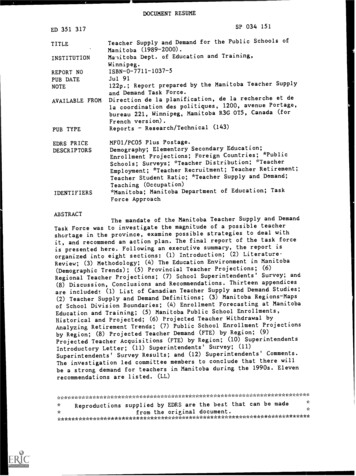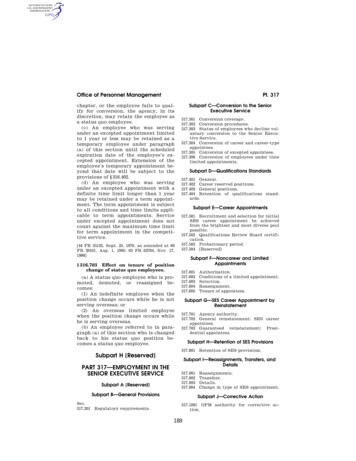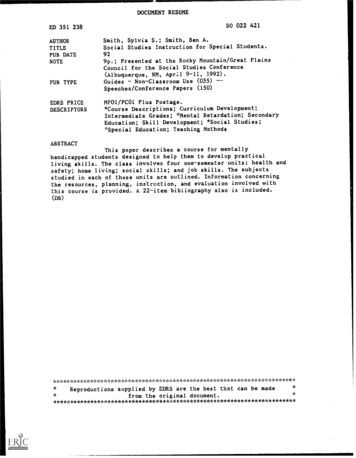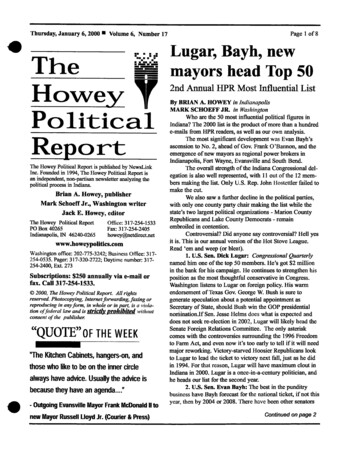
Transcription
DOCUMENT RESUMESP 034 151ED 351 317TITLEINSTITUTIONREPORT NOPUB DATENOTEAVAILABLE FROMPUB TYPEEDRS PRICEDESCRIPTORSIDENTIFIERSTeacher Supply and Demand for the Public Schools ofManitoba (1989-2000).Malitoba Dept. of Education and Training,Winnipeg.ISBN-0-7711-1037-5Jul 91122p.; Report prepared by the Manitoba Teacher Supplyand Demand Task Force.Direction de la planification, de la recherche et dela coordination des politiques, 1200, avenue Portage,bureau 221, Winnipeg, Manitoba R3G OT5, Canada (forFrench version).Research/Technical (143)ReportsMF01/PC05 Plus Postage.Demography; Elementary Secondary Education;Enrollment Projections; Foreign Countries; *PublicSchools; Surveys; *Teacher Distribution; *TeacherEmployment; *Teacher Recruitment; Teacher Retirement;Teacher Student Ratio; *Teacher Supply and Demand;Teaching (Occupation)*Manitoba; Manitoba Department of Education; TaskForce ApproachABSTRACTThe mandate of the Manitoba Teacher Supply and DemandTask Force was to investigate the magnitude of a possible teachershortage in the province, examine possible strategies to deal withit, and recommend an action plan. The final report of the task forceis presented here. Following an executive summary, the report isorganized into eight sections: (1) Introduction; (2) Literature.Review; (3) Methodology; (4) The Education Environment in Manitoba(Demographic Trends); (5) Provincial Teacher Projections; (6)Regional Teacher Projections; (7) School Superintendents' Survey; and(8) Discussion, Conclusions and Recommendations. Thirteen appendicesare included (1) List of Canadian Teacher Supply and Demand Studies;(2) Teacher Supply and Demand Definitions; (3) Manitoba Regions-Mapsof School Division Boundaries; (4) Enrollment Forecasting at ManitobaEducation and Training; (5) Manitoba Public School Enrollments,Historical and Projected; (6) Projected Teacher Withdrawal byAnalyzing Retirement Trends; (7) Public School Enrollment Projectionsby Region; (8) Projected Teacher Demand (FTE) by Region; (9)Projected Teacher Acquisitions (FTE) by Region; (10) SuperintendentsIntroductory Letter; (11) Superintendents' Survey; (11)Superintendents' Survey Results; and (12) Superintendents' Comments.The investigation led committee members to conclude that there willbe a strong demand for teachers in Manitoba during the 1990s. Elevenrecommendations are listed. *********Reproductions supplied by EDRS are the best that can be madefrom the original ******************************
U.S. DEPARTMENT OFOffice of Educatronl ResearcnEDUCATIONand trnprovernen.EDUCATIONAL RESOURCES INFORMATIONCENTER (ERIC)C This document has been reproduced asrecerved from the person or oroamtatron"PERMISSION TO REPRODUCEMATERIAL HAS BEEN GRANT'T'ra-1-7aLortomatrno 1C Mmor changes have been made to improvereproduction atalli yPornts of vew or oolmons stated . thrsdocu.ment do not neCessarrly represent Otte's'OERI 00Srhon or pokyBEST COPY FIALATO THE EDUCATIONAL RESOUINFORMATION CENTER (ERIC)
Teacher Supply and DemandFor the Public Schools of Manitoba(1989 - 2000)A Report Prepared byThe Manitoba Teacher Supply and Demand Task ForceJuly 1991Pour un exemplaire francais du present rapport adressez-vous a la Direction de la planification, de larecherche et de la coordination des politiques, 1200, avenue Portage, bureau 221, Winnipeg, 113G 0T5,
ISBN0-7711-1037-5
BRANDON UNIVERSITYBRA.NDON, MANITOBA. CANADAR7A 6A9Office of the DeanFaculty of EducationThe Honourable Len DerkachMinister of Education,Legislative Building,Winnipeg, Manitoba,July 16, 1991R3C 0V8Dear Mr. Derkach:I have the honour to submit to you the final report of the Task Force on Teacher Supplyand Demand, entitled "Teacher Supply and Demand for the Public Schools of Manitoba (1989-2000)'.Task Force members have worked assiduously and thoughtfully on this report, and webelieve that we have done a reasonable examination of the supply and demand of teachers inManitoba for the next decade.The report proper is preceded by an Executive Summary, which Includes 11recommendations.I will be happy to meet with you and members of the Department of Education to discussthe report, as will members of the Task Force.Thank you for this opportunity to serve the citizens of Manitoba.Your,verb fru!,obi J Enns, Ph.D.,ask F rce Chair,Dean, acuity of Education.xc.Ms. Betty Husby, Manitoba Teachers SocietyMr. Alex Krawec, Manitoba Education and TrainingDr. Roger Legal, College universitaire de Saint-BonifaceDr. Annabelle Mays, University of WinnipegMr. Jim McKay, Red River Community CollegeDr. Jerry MacNeil, Manitoba Association of School TrusteesMr. Strini Reddy, Manitoba Association of School SuperintendentsDr. John Stapleton, University of Manitobagi
Executive SummaryIn January 1990, the Minister of Education and Training established a ManitobaTeacher Supply and Demand Task Force. The mandate of the task force was to investigatethe magnitude of a possible teacher shortage, examine possible strategies to deal with it, andrecommend an action plan to the Minister. Members appointed to the task force includedrepresentatives from the provincial teacher education institutions, teachers, superintendents,trustees, and Manitoba Education and Training.In carrying out its mandate, the task force committee conducted the followingactivities:a review of the relevant literaturean historical analysis of student enrolments and pupil-teacher ratios in Manitobaan investigation of teacher supply and demand modelling procedures and formulasa calculation of ten-year projections of provincial teacher demand, teacheracquisitions, and required beginning teachersa calculation of five-year projections of regional teacher demand and teacheracquisitionsa survey of Manitoba school superintendents regarding teacher supply and demandprojections for their divisions.The task force investigation led committee members to conclude that there will bea continuing strong demand for teachers within the province over the next decade. In 198990, 1,063 teacher acquisitions were required and of these 47% were beginning teachers whowere newly certified in the previous year. Based upon a projected slow declining studentenrolment throughout the decade, a constant pupil-teacher ratio of 15.19, and an annualteacher withdrawal rate of 8%, it was concluded that slightly in excess of 1,000 teacheracquisitions would be required for each year until 1999-2000.On a regional basis, the annual demand for teachers was projected to remain thehighest within Greater Winnipeg. Northern Manitoba was projected to continue to have thegreatest difficulty in acquiring and retaining teachers, even though requiring the fewest innumber. The task force concluded that northern Manitoba would experience an annualteacher withdrawal rate which is much higher than both Greater Winnipeg and ruralManitoba.The subject/program areas projected by school superintendents as having the greatestdemand for teachers were resource teaching, Core French, French Immersion, music, andspecial needs.
As a result of its deliberations,recommendations:1.the Task Force submits theThat the level of provincial funding to universities be increased onan annual basis to maintain current enrolment levels withinBachelor of Education degree programs.2.3.That Manitoba Education and Training produce annual projectionsof provincial teacher demand.That Manitoba Education and Training review the mandate,specifications, and contents of the existing teacher (ProfessionalSchool Personnel) data base.4.That Manitoba Education and Training, in consultation withManitoba Teachers' Society, Manitoba Association of SchoolSuperintendents, and Manitoba Association of School Trustees,conduct a study of the relationship between the changing classroomenvironment and teacher supply and demand.5.That Manitoba Education and Training provide rural and northernschool boards with additional funding to attract and retain certifiedteachers.6.That Manitoba Education and Training in partnership withuniversities, ensure that teacher education programs providestudents with experiences specifically related to rural and northernenvironments and that adequate funding be provided for this.7.That school boards provide the necessary professional developmentfor teachers to facilitate re-deployment to subject /program areas inwhich vacancies occur, and that incentive grants be provided toensure teachers are retrained as required.8.That Manitoba Education and Training in collaboration with theuniversities, encourage teachers to specialize in resource,counselling and special needs programs and that specialopportunity bursaries be provided to teachers who choose to train inthese specialty areas.9.That the government-sponsored Access programs related to teachereducation receive increased provincial fisnding.iifollowing
10.That Manitoba Education and Training, in partnership with theuniversities, work to increase the participation of aboriginal andvisible minority people within teacher education programs.11.That Manitoba Education and Training establish and capitalize anEducational Research Council which would provide funds forresearch on educational issues deemed to be of the public's interest.
PrefaceIn recent years, representatives from Manitoba Teachers' Society, ManitobaAssociation of School Superintendents, and Manitoba Association of School Trustees haveraised concerns about current and future teacher supply and demand. In January 1989, theCanadian Teachers' Federation investigated the issue and released the report Projection ofElementary and Secondary Enrolment and the Teaching Force in Canada, 1987-88 to 2006-07.The report projected that Manitoba would experience an increased demand for secondaryteachers throughout the decade, and an increased demand for elementary teachers until1996-97, followed by a decline.In January, 1990, Education and Training Minister Len Derkach established aManitoba Teacher Supply and Demand Task Force. Its mandate was to investigate themagnitude of a possible teacher shortage, examine possible strategies to deal with it, andrecommend an action plan to the Minister of Education and Training.Dr. Robin Enns, Dean of Brandon University's Faculty of Education, was asked tochair the task force committee. Serving on the committee were the following representativesfrom Manitoba's educational community:Dr. Robin EnnsMs. Betty HusbyMr. Alex KrawecDr. Roger LegalDr. Annabelle MaysDr. Jerry MacNeilMr. Jim McKayMr. Strini Re ddyDr. John StapletonBrandon UniversityManitoba Teachers' Society (MTS)Manitoba Education and TrainingCollege universitaire de Saint-BonifaceUniversity of WinnipegManitoba Association of School Trustees (MAST)Red River Community CollegeManitoba Association of School Superintendents (MASS)University of ManitobaTechnical support was provided by the Planning, Research and rolicy Coordination Branch,Manitoba Education and Training.The task force committee held regular meetings through 1990 to July 1991. Alldecisions regarding the focus, scope, and procedures of the study, as well as therecommendations and structure of the report, were made by consensus.
Table of ContentspageExecutive SummaryPmf ceviiTab It. of ContentsList of Tables1.2.3.4.5.xiINTRODUCTIONBackground1.1Terms of Reference1.212LITERATURE REVIEWThe Teacher Labour Market2.1Canadian Teacher Supply and Demand Studies2.2Choosing a Forecasting Model2.3METHODOLOGYConceptual Framework Study3.1Examination u, Historical Trends3.2Projection of Teacher Demand,3.3Acquisitions and Beginning TeachersSchool Superintendents' Survey3.4THE EDUCATION ENVIRONMENT IN MANITOBA(DEMOGRAPHIC TRENDS)Student Enrolments4.1Teacher Trends4.2Teacher Education Student Patterns4.3PROVINCIAL TEACHER PROJECTIONSSelection of Appropriate Model5.1Teacher Demand Projections5.2Teacher Acquisition Projections5.3Beginning Teacher 242833
pageREGIONAL TEACHER PROJECTIONSSelection of Procedure and Timeframe6.1Teacher Demand Projects6.2Teacher Acquisition Projections6.36.394041SCHOOL SUPERINTENDENTS' SURVEY7.7.17.27.37.47.5Methodology43Student Enrolment Patterns and ProjectionsSchool Personnel and Position VacanciesThe 1990/91 SituationSuggested Strategies for Manitoba Educationand Training4444DISCUSSION, CONCLUSIONS AND RECOMMENDATIONS8.1Projection Modelling8.2School Superintendents' Survey8.3Teacher Supply and Demand - Nationaland InternationalMajor Conclusions and Recommendations8.48.454849505152APPENDICESA.List of Canadian Teacher Supply and Demand Studies55B.Teacher Supply and Demand Definitions56C.Manitoba Regions - Maps of School DivisionBoundaries59Enrolment Forecasting at Manitoba Educationand Training62Manitoba Public School Enrolments,Historical and Projected64Projected Teacher Withdrawal by AnalyzingRetirement Trends65Public School Enrolment Projections by Region66D.E.F.G.viii
pageH.Projected Teacher Demand (FTE) by Region67I.Projected Teacher Acquisitions (FTE) by Region68J.Superintendents' Introductory Letter71K.Superintendents' Survey73L.Superintendents' Survey Results83M. Superintendents' Comments90FIGURESTHE EDUCATION ENVIRONMENT IN MANITOBADEMOGRAPHIC ;REND GRAPHICSFigure 1Manitoba Population Aged 15-1793Figure 2Manitoba Births93Figure 3Manitoba Population by Age Group94Figure 4Public Schools Enrolments95Figure 5Public School Enrolments by Location95Figure 6Public School Enrolment by EducationalCategory96Figure 7Public School Teachers96Figure 8Public School Teachers by Type of Position97Figure 9Public School Teachers by Position and Sex97Figure 10Public School Teachers Average Age byCategory98Figure 11Public School Teachers by Location98Figure 12Public School TeachersDistribution99ix
pagePublic School Teachers Average Age byLocationProportion of Teachers withOut-of-Province Experience100Figure 15Teacher Retirements100Figure 16Public School FT Z TeacherAides101Manitoba Faculties of EducationEnrolments101Manitoba Education Graduates102Figure 13Figure 14Figure 17Figure 1899103REFERENCESx
LIST OF TABLESpageTable 1Historical Pupil-Teacher Ratios25Table 2Teacher Demand Scenarios26Table 3Teacher Demand Graphic Representation27Table 4Percent Change in Teacher Demand(1989-90 to 1999-2000)28Historical Teacher Movement WithinTeaching Force (1986-87 to 1989-90)291999-2000 Acquisition Requirements,According to Four Demand Scenarios andFive Withdrawal Assumptions30Projected Acquisitions According toFive Withdrawal Assumptions311999-2000 Acquisition Rates, Accordingto Four PTR Scenarios and FiveWithdrawal Assumptions32Composition of Acquisitions(1986-87 to 1989-90)34Composition of 1989-90 TeacherAcquisitions34Table 11Beginning Teacher Requirements35Table 12Projected Beginning Teachers According toFour Withdrawal Assumptions36Manitoba University Graduates Employedas Teachers in Public Schools (1987-90)37Table 14Regional Demographics (1988-90)4.0Table 15Regional Teacher Demand Scenarios(1989-90 Compared to 1994-95Projections)41Table 5Table 6Table 7Table 8Table 9Table 10Table 13
pageTable 16Regional Teacher Acquisitions(1994-95)42Table 17Superintendents' Survey Response Rates43Table 18Comparison of 1990-91 Actual andProjected Figures505xii
1. 1N7WODUC770N1.1BackgroundManitoba's changing demographics have created an interest in the adequacy of theprovince's supply of teachers. Due to an "aging teaching force", a concern has emergedregarding the effects of future teacher retirements on the supply of teachers. At the sametime, the current economic recession has caused many Manitoba school boards to reevaluate their program offerings and need for teachers, resulting in a reduction of teacherpositions.In Manitoba, as in other provinces, demographic and social patterns are changing ata rapid pace. Specific to the provision of education are:declining rural population-decreasing student enrolmentsincreasing difficulties in attracting and retaining teachersfinancial constraintsto university education programs, leading to restricted enrolments and fewergraduatesto school divisions/districts, causing re-evaluation of priorities and programdelivery mechanismspublic demand for the continuation of, and increase in, program offerings-a diversified and expectant public continues to operate according to the "addon" philosophy for meeting new and changing education needschanging labour force practicesgreater numbers of people are entering and changing careers as "adults." Thisresults in experienced teachers leaving the profession early (creatingvacancies), and other adults wanting to enter the profession (altering thebackground and experience of the traditional 18-24 age group of collegestudents).Over the past ten years, student enrolments within Manitoba's schools have graduallydecreased, while the number of teachers has gradually increased. How these trends willchange or continue is uncertain.It is within this complex environment, that the following study was conducted.1tG
1.2Terms of ReferenceThe task force committee decided that the following criteria would structure the workof the study:the scope would include analysis of Manitoba's public school systema synthesis of the literature on teacher supply and demand would be conductedwith particular attention given to recent Canadian studiesa statistical model would be utilized to project teacher demand for each of thenext 10 yearsa qualitative examination of teacher supply and demand in Manitoba would beconducted by surveying provincial superintendents.Based upon discussion, the primary research questions of this study became:Quantitative:-What will be the demand for teachers in Manitoba in each year of the nextdecade?-What will be the number of required teacher acquisitions in each year of thenext decade?-What will be the number of beginning teachers required in each year of thenext decade?Qualitative:What are the key factors influencing teacher supply and demand in Manitoba?What are the current issues facing school administrators with respect toteacher supply and demand?2
2. LITERATURE REVIEWIn order to develop a comprehensive conceptual framework for the study 'TeacheiSupply and Demand for the Public Schools of Manitoba (1989-2000)", an analysis of thefollowing types of literature/research was conducted:the teacher labour market environment (in general)Canadian studies specific to teacher supply and/or demandthe base upon which to choose a projection model.2.1The Teacher Labour MarketAnalyses of recent North American studies, reports, and treaties revealed thefollowing trends related to the teacher labour market:2.1.1Factors affecting the teacher labour market are numerous, intertwined andcomplex.According to George Psacharopoulos (1987), planning for future teacher demand canbe defined as securing the desired quantities and qualities of teachers according tothe resources available for attracting, training and recruiting them. As the definitionsuggests, the factors which influence the teacher labour market can be numerous andcomplex.In their critique of teacher labour market studies, Berry, Nobiit and Hare (1985)identified the following "influencing factors" in the literature:Student-Teacher ratioDemographic patternsImmigrationEconomic shifts and trendsTeacher career aspirationsTeacher characteristicsDeferred salary optionsSpecial programmingWorking conditions/incentivesHiring of paraprofessionalsBirth RateStudent Retention RateEmigrationCurriculum reformTcacher mobilityTeacher retirementSabbatical leaveEducational policy changesImpact of technologyRegional/community characteristicsAccording to Berry, Nob lit and Hare (1985), each of the above factors plays animportant role regarding teacher supply and demand. They suggested that anyinvestigation of teacher supply and demand should incorporate as many of thesefactors as possible.3[3
2.1.2Many important, influencing factors are qualitative, tenuous and difficult tomeasure.Since the 1983 National Commission on Excellence's Nation at Risk (U.S.A.),research on the quality of the teacher labour market has increased sharply. Thefocus of much of this literature (Schlechty & Vance, 1983; Weaver, 1983) has beenthe quantitative analysis of the teaching ability and content knowledge of the teacherwork force.To some extent, these studies have been useful in bringing out such policies as careerladders and incentives to attract, reward and retain quality teachers. This reflects thenational economic concept that talent will eventually flow to opportunity. However,as Bird (1984) pointed out, the variables affecting the teacher labour market are farmore complex and subtle than most analysts and policy makers may believe.According to Bird (1984), ensuring an adequate supply of competent teachers mayinvolve many more factors than a mere increase in funding and the provision ofhigher salaries and incentives. He wrote:Quantitative studies, which have been the impetus for current reforms,often miss the mark since they are restricted to predetermined categoriesand questions. Subsequently, most of the studies on the teacher labourmarket have focused on the seemingly moot question, "why do teachersleave?" while ignoring many salient questions, including:1. What are the documents of entry, existing, and reentry ofteachers?2. How do these dynamics vary in different geographic, economic, andcultural contexts?3. What teacher characteristics are actually desired and needed byvarious school systems?4. What are effects of working conditions on teacher mobility and jobsatisfaction?5. Given the above, "Why do teachers stay?" (p. ii)2.13 Qualitative and quantitative approaches should not be perceived asdichotomous or separate from each other. Rather, the two approaches shouldcomplement each other.Berry, Nob lit and Hare (1985) stressed that many influencing, qualitative factorscannot be identified before data collection and analysis begin. To be useful to policymakers, it is important to examine the data carefully and begin the complex processof attempting to understand the underlying trends, causes and effects as well as therelationships of all the influencing variables.4
Bird (1984) argued that there is a need to go beyond linear relationship, ofquantitative measures of variables in an attempt to answer research questions. Acareful examination of a quantitative analysis of data can lead to refining andtransforming the research questions to render them more meaningful and morepowerful.2.1.4Current societal transformations and their impact on education are creatingincreasing diZiculties in forecasting the teacher labour market.According to Williams (1987) the basic, rational economic model of supply anddemand was more appropriate to the teacher labour market a decade ago than it istoday. He argues that the shift from the industrial society to the information societyhas changed the nature of the teaching force. According to Williams, there werethree conditions that made forecasting easier during the industrial age. Theseconditions were:To a large extent, education was a single-occupation undertaking, dominated byteachers. In the educational enterprise, complementarity and substitutionbetween teachers and other professionals are limited.In most countries, teachers were mainly employed by the public authorities, thenear monopolists (sole buyers) of teachers' services, so that decision-makingabout needs and employment was centralized.The concept of the "classroom teacher" was a dominant feature of the educationsystem. Close to this concept was the pupil-teacher ratio which converted givenenrolments of learners into appropriate numbers of teachers.With the advent of the information society, these conditions have begun to change.Norman Henchey (1983) identified these changes:New technologies such as interactive video, distance education and computerassisted learning have had a major impact on the traditional classroom teacherconcept. There are training opportunities offered by the media through private,public and educational broadcasting, expanded by satellite, cable and videorecording systems which allow students to schedule their own education.The quality of knowledge and learning has also been developing, especially in therange, sophistication and complexity of the theories and practices of teaching.At a more fundamental level, there are indications of a paradigm shift in ourunderstanding of the curriculum, the learning process and teaching. Thefragmentation of knowledge into components like grades, levels, subjects andspecialty areas is being seriously challenged and replaced by new concepts suchas knowledge integration, process, generic skills, holistic learning and outcomes.
The impact of these changes on the teacher labour market is far reaching andyet to be realized.Learning is no longer restricted to the classroom and the classroom teacher.Business, industry, communities and other agencies are playing an increasing roleit education. Paraprofessionals and professionals other than teachers areincreasing in numbers and assuming more responsibilities which were once thedomain of the teacher.2.1.5Teacher shortages tend to vary widely by specialty area, geographic region,and degree of urbanization.Recent studies and articles (Robert, 1988; Denton, 1988; Dyck, 1987; Kloosterman,1987; Hecker, 1986; Dobbs, 1986; Cornett, 1986; Champagne, 1986) suggest thatshortages of teachers in specialty areas is a growing concern. According to thesearticles, the capacities and resources of teacher training institutions cannot meet thedemand for specialty area teachers. Although the demand varies from region toregion, current specialty areas identified in these articles included science andtechnology, fine arts, special education and vocational education.With respect to geographic location, recent studies (Clark, 1987; Ward, 1987; Scott,1987; Bruno, 1986; Lutzer, 1986; Gosman, 1986) indicate that geographic locationis a major influencing factor in the teacher labour market. From these studies, apattern emerged. Rural and isolated school systems appear to have significantlygreater problems in recruiting and retaining teachers than urban divisions. As aresult, rural education systems appear to have become aggressive in implementingvarious incentives (i.e., special pay allowances, educational leaves, opportunities forcareer advancements) to attract teachers.2.1.6French and Native self-governance is receiving paramount attention in oursociety.This will have a major impact on the teacher labour market.However, it is not fully understood what this impact will be.Literature on the educational impact of Meech Lake is sparse and virtually nonexistent. However, recent articles (Couture, 1987; Cummins, 1987; Mulcahy andMarfo, 1987) argue that French and Native self-governance in education will changethe teacher labour force drastically. Cultural values will challenge and change therequired competencies of teachers and the foundation and philosophy of the entireeducation system.2.1.7Increased emphasis on cultural diversity has added a new dimension andchallenge to the teacher labour market.Increasing the participation of minority groups in the teacher labour market is a
major thrust in North American literature (Webb, 1986; Tewel, 1987; Leonard, 1988;Hopkins, 1989). The majority of the literature has dealt with effective strategies forrecruiting minority teachers, such as:developing curriculum programs and practices in teacher training institutions thatenable minority students to enter teacher education and successfully completerequirements for admission to the professionproviding financial assistance to minority studentsincorporating the principle of cultural diversity in teacher education programs.2.1.8The fast pace of societal change and educational reform presents difficultiesin projecting accurate, long term, teacher labour market forecasts.Uncertainty about the future is a common theme in the literature which examines thefuture teacher labour market. Nonetheless, some of the literature (Cooper, 1984;Keough, 1986; Starr, 1986; Rosenfeld, 1986; Duenk, 1987; Henchy, 1987; Groff, 1988;Leonard, 1988; Berry, 1988; Bowen, 1988) has predicted an increased demand for allteachers to have skills and knowledge in the following areas:science and technologygeneric skillscounselling and knowledge in personal and social developmentknowledge of business, industry and the transition from school to workglobal, critical and creative thinkingentrepreneurshipmoral and ethical reasoningsustainable development.2.1.9There is an increasing need to invest more resources in effective planning ofteacher supply and demand.According to Williams (1987), actual, recent experiences have shown seriousmiscalculations in forecasting the teacher labour market. Williams argued that thesedifficulties reflect, to a large extent, problems in correctly estimating future:7
changes in enrolmentchanges in attrition of teachers through death, retirement, resignation, and soforthchanges in special programschanges in the pupil-teacher ratio through alteration of pupil hours per week,teacher hours per week, or class sizechanges in political/economic conditions.In search of a balanced development of the teaching force, several researchers(Tiernay, 1985; Hawley, 1986; Engleking, 1987; Murnane, 1988; Berry, 1988) havesuggested the following strategies to improve the research and planning of teachersupply and demand:developing a reliable and accurate bank of information on student enrolmentsand other pertinent demographic information.ensuring that education institutions become knowledgeable of and sensitive tolabour market forces indigenous to their locale.developing more cooperation between institutions to centralize resources in theplanning of teacher supply and demand. Tierney (1985) argued that without thi
ED 351 317. SP 034 151. TITLE Teacher Supply and Demand for the Public Schools of. Manitoba (1989-2000). INSTITUTION Malitoba Dept. of Education and Training, Winnipeg. REPORT NO ISBN--7711-1037-5 PUB DATE Jul 91. NOTE. 122p.; Report prepared by the Manitoba Teacher Supply. and Demand Task Force. AVAILABLE FROM Direction de la planification .










